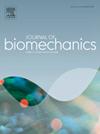Knee functional calibration strengthens the relationship between lower limb bone morphology and hip rotation during gait
IF 2.4
3区 医学
Q3 BIOPHYSICS
引用次数: 0
Abstract
The position of the femur’s greater trochanter is crucial to produce the required hip abduction moment during gait. Clinical parameters describing the shape of the femur, such as femoral neck anteversion and neck shaft angles, influence the lever-arm of abductor muscles. In children with cerebral palsy, abnormal lower limb bone shapes may impair function, highlighting the importance of clinical gait analysis for surgical decision. Here, we re-examined a dataset on the correlation between 3D lower limb bony morphology and hip rotation kinematics during gait.
This study was a secondary analysis of a dataset from 121 children with cerebral palsy. 3D bony morphology was determined by a bi-planar, low dose, digital x-ray system and gait analysis utilised the conventional gait model with or without two functional knee calibration algorithms. The results indicated that functional calibration improved the variance explained by linear regression models between 3D bony morphology and the mean hip rotation during gait. Furthermore, femoral neck anteversion and neck shaft angles were now identified as significant predictors in the models. Despite differences between the functional algorithms, results of the associated regression models were similar.
However, bony morphology alone did not fully explain hip rotation, suggesting other factors are involved. We noted limitations in functional calibration due to soft tissue artifacts and insufficient knee range of movement. Previous results on the relationship between bony morphology and gait may be revisited considering the findings of this study.
膝关节功能校准加强了步态中下肢骨形态与髋关节旋转之间的关系
在步态中,股骨大转子的位置对于产生所需的髋外展力矩至关重要。描述股骨形状的临床参数,如股骨颈前倾和颈轴角,影响外展肌的杠杆臂。在脑瘫儿童中,异常的下肢骨形状可能损害功能,强调临床步态分析对手术决策的重要性。在这里,我们重新检查了步态期间三维下肢骨形态和髋关节旋转运动学之间的相关性数据集。这项研究是对121名脑瘫儿童数据集的二次分析。三维骨形态由双平面、低剂量、数字x线系统确定,步态分析采用常规步态模型,有或没有两种功能性膝关节校准算法。结果表明,功能校准改善了三维骨形态与步态中平均髋关节旋转之间线性回归模型解释的方差。此外,股骨颈前倾和颈轴角现在被确定为模型中的重要预测因子。尽管函数算法之间存在差异,但相关回归模型的结果相似。然而,骨形态本身并不能完全解释髋关节旋转,这表明有其他因素参与其中。我们注意到由于软组织伪影和膝关节活动范围不足导致的功能校准的局限性。考虑到本研究的结果,先前关于骨形态和步态之间关系的结果可能会被重新审视。
本文章由计算机程序翻译,如有差异,请以英文原文为准。
求助全文
约1分钟内获得全文
求助全文
来源期刊

Journal of biomechanics
生物-工程:生物医学
CiteScore
5.10
自引率
4.20%
发文量
345
审稿时长
1 months
期刊介绍:
The Journal of Biomechanics publishes reports of original and substantial findings using the principles of mechanics to explore biological problems. Analytical, as well as experimental papers may be submitted, and the journal accepts original articles, surveys and perspective articles (usually by Editorial invitation only), book reviews and letters to the Editor. The criteria for acceptance of manuscripts include excellence, novelty, significance, clarity, conciseness and interest to the readership.
Papers published in the journal may cover a wide range of topics in biomechanics, including, but not limited to:
-Fundamental Topics - Biomechanics of the musculoskeletal, cardiovascular, and respiratory systems, mechanics of hard and soft tissues, biofluid mechanics, mechanics of prostheses and implant-tissue interfaces, mechanics of cells.
-Cardiovascular and Respiratory Biomechanics - Mechanics of blood-flow, air-flow, mechanics of the soft tissues, flow-tissue or flow-prosthesis interactions.
-Cell Biomechanics - Biomechanic analyses of cells, membranes and sub-cellular structures; the relationship of the mechanical environment to cell and tissue response.
-Dental Biomechanics - Design and analysis of dental tissues and prostheses, mechanics of chewing.
-Functional Tissue Engineering - The role of biomechanical factors in engineered tissue replacements and regenerative medicine.
-Injury Biomechanics - Mechanics of impact and trauma, dynamics of man-machine interaction.
-Molecular Biomechanics - Mechanical analyses of biomolecules.
-Orthopedic Biomechanics - Mechanics of fracture and fracture fixation, mechanics of implants and implant fixation, mechanics of bones and joints, wear of natural and artificial joints.
-Rehabilitation Biomechanics - Analyses of gait, mechanics of prosthetics and orthotics.
-Sports Biomechanics - Mechanical analyses of sports performance.
 求助内容:
求助内容: 应助结果提醒方式:
应助结果提醒方式:


